
The Talent is a multiple unit railcar manufactured by Bombardier that was developed by Waggonfabrik Talbot in Aachen shortly before the company was acquired by Bombardier in 1995. The name Talent is an acronym in German for TALbot LEichter Nahverkehrs-Triebwagen.
Die Länderbahn GmbH (DLB), formerly Vogtlandbahn GmbH, is a German rail transport company based in Viechtach, operating transport services originally only in the Vogtland, but now also on a regional basis. Die Länderbahn is a subsidiary of Regentalbahn AG, which is owned by Ferrovie dello Stato subsidiary Netinera. The term vogtlandbahn remains in use as a trademark of Die Länderbahn in Vogtland.
The Stadler Regio-Shuttle RS1 is the first widely used, new-generation, diesel railcar in Germany and Czech Republic for local railway services. Its most characteristic feature is the trapezium-shaped window frames. The Regio-Shuttle is classified by the Deutsche Bahn as Class 650, by the České Dráhy as Class 840 or Class 841, however numerous private railways have their own Regio-Shuttles.
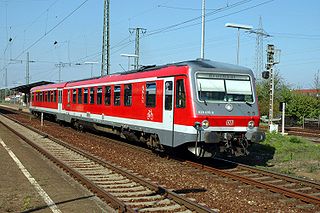
The DB Class 628 is a twin-car, diesel multiple unit operated by the Deutsche Bahn for local passenger rail services.

The Interregio-Express (IRE) is a local public transport railway service operated by the Deutsche Bahn which is only available in the German states of Baden-Württemberg, Bavaria, Saxony, Saxony-Anhalt and Berlin as well as in Switzerland. The IRE service was first introduced in the 2001 summer timetable, due to the increasing abolition of Interregio routes by DB's long-distance division. As a result, several German states ordered InterRegioExpress trains on the routes affected. In addition IRE trains were also introduced on routes that had not previously had an Interregio service.
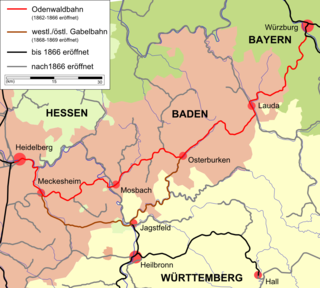
The Odenwald Railway was the name given to a Baden railway line in southwestern Germany built from between 1862 and 1866. It ran from Heidelberg via Neckargemünd and Meckesheim through the Little Odenwald mountains to Waibstadt, Mosbach, Osterburken and Lauda to Würzburg in Bavaria.

The Tauber Valley Railway is a single-tracked, unelectrified, standard gauge railway between Wertheim and Crailsheim in the state of Baden-Württemberg in southern Germany. It runs alongside the Tauber to Weikersheim, then along the Vorbach and Blaubach rivers. It is recorded in the timetable as route no. 782. Until 9 December 2006 it had been route no. 788.
The Main Valley Railway is a single-tracked, main line running alongside the river Main in Bavaria and Baden-Württemberg in southern Germany. In Miltenberg it connects to the Miltenberg–Walldürn railway. It also has a junction with the Tauber Valley Railway at the Baden town of Wertheim, that runs to Crailsheim.
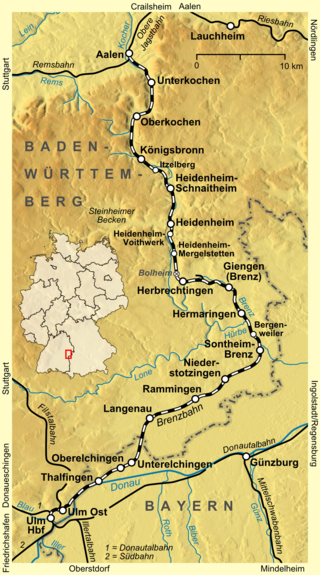
The Aalen–Ulm railway, also called the Brenzbahn or the Brenztalbahn, is a single-tracked, non-electrified main line from Aalen to Ulm in southern Germany. It is 72.5 km (45.0 mi) long and, for 27 km (16.8 mi), follows the Brenz River that gives it its name.

The Ulm–Friedrichshafen railway, also known as the Württembergische Südbahn, is an electrified main line in the state of Baden-Württemberg, southern Germany. It was built from 1846 to 1850 and doubled from 1905 to 1913. During that time many of the station buildings were rebuilt. Its kilometre numbering (chainage) begins as the Fils Valley Railway in Stuttgart Hbf. The line was upgraded and electrified from the spring of 2018. Electric operations commenced in December 2021.

The Franconia Railway is a 180-kilometre-long (110 mi) railway line in the north of the German state of Baden-Württemberg and the Bavarian province of Lower Franconia that links Stuttgart and Würzburg. Its name comes from the fact that the majority of the line runs through Franconia. The first section of the line was opened in 1848 and is one of the oldest lines in Germany. The main line is now electrified and has been almost entirely upgraded to double-tracks.

The Brunswick–Uelzen railway line is a largely, single-tracked, non-electrified branch line in the north German state of Lower Saxony. It serves the northern part of Brunswick Land and the eastern region of the Lüneburg Heath. The most important station en route is Gifhorn. The line has also been called the Mühlenbahn for several years due to the many mills along its route.
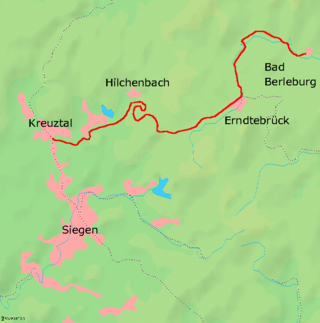
The Erndtebrück–Bad Berleburg railway is a 20 km long branch line that branches off the Kreuztal–Cölbe railway from Erndtebrück to Bad Berleburg. In Bad Berleburg there used to be a connection to the now largely dismantled Bad Berleburg–Allendorf railway to Frankenberg. The single-track, non-electrified railway line is operated as a single block branch line.

The Crailsheim–Heilbronn railway is a double-tracked, main line railway in southwest Germany that runs from Heilbronn, crossing the Hohenlohe region.

Crailsheim station is a junction station in the German state of Baden-Württemberg where four railway lines converge. It lies at the 30.4 km point on the Upper Jagst Railway, with the chainage continuing on the Hohenlohe Railway. The chainage on the Tauber Valley Railway and the line to Nuremberg starts at the station. With its four platform tracks and numerous passing tracks and sidings, it is the largest station in the district of Schwäbisch Hall. It is by served by Intercity and regional trains.
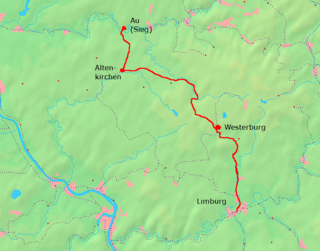
The Limburg–Altenkirchen railway is a 65.1 km long branch line from Limburg via Westerburg to Altenkirchen and connecting via the Engers–Au railway to Au through the Westerwald. In German the line is also known as the Oberwesterwaldbahn. It runs through the German states of Hesse and Rhineland-Palatinate.

Öhringen Hauptbahnhof is a station on the Hohenlohe Railway in Öhringen in the German state of Baden-Württemberg. The station is classified by Deutsche Bahn as a category 5 station. The station is part of the zone of the KreisVerkehr Schwäbisch Hall and is the largest and most important station of the Hohenlohe district.

Lauda station is a junction station in the town of Lauda-Königshofen in the German state of Baden-Württemberg, where the northern section of the Tauber Valley Railway branches from the Franconia Railway. Lauda station is classified by Deutsche Bahn as a category 5 station.
The Kassel-based Kurhessenbahn (KHB) is the first of six regional networks to be created by Deutsche Bahn AG as part of its middle class offensive. It forms a unit that is formally split into DB RegioNetz Verkehrs GmbH and DB RegioNetz Infrastruktur GmbH in order to comply with the legal requirements after separation of network and operations.

DWA LVT/S is a diesel multiple unit for regional traffic with low-floor entry.




















